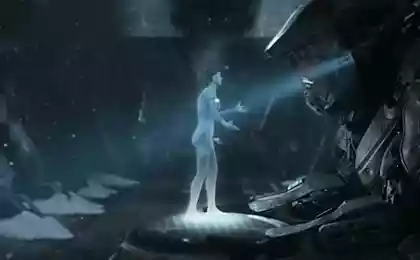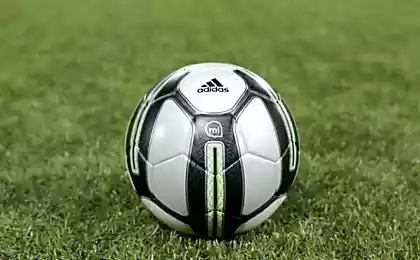1439
Sacred, terrible and clever
We know that the crocodile - a bloodthirsty predator. It is. He is dangerous even for sharks. However, scientists do not get tired to open new facets of this ancient reptile. It turns out that crocodiles is not so primitive, even clever.
A small overview.
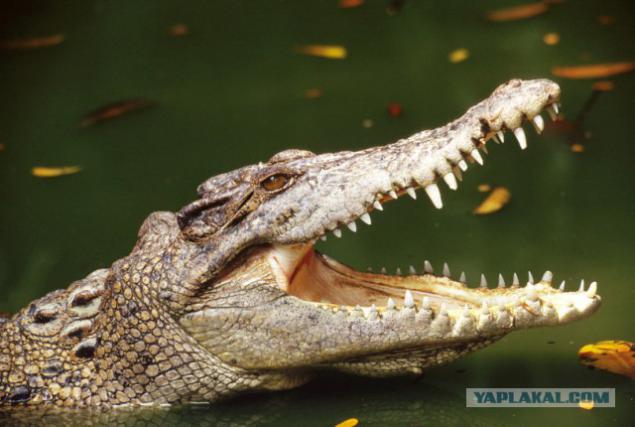
The most ancient lizard
Crocodiles inhabit the planet another 250 million years ago. They began his earthly journey solely as land animals, and only after millions of years moved into waterways.
Dimensions of prehistoric crocodiles were matched to their relatives - dinosaurs. So, one of the extinct species sarcosuchus imperator in length up to 12 meters! By the way, today's crocodiles have more kinship with dinosaurs, and even with birds than modern reptiles.
The living conditions of the crocodiles have changed little since the days of the Triassic period, which partly explains the preservation of their populations.
Millions of years of evolution have created an almost universal organism to adapt to a predatory lifestyle in a variety of habitats. The Company now crocodiles salt metabolism, which gives them the opportunity to live in the sea water, their heart has four chambers framework to better nourish the body with oxygen, they have developed cerebellum contributes to the high coordination.
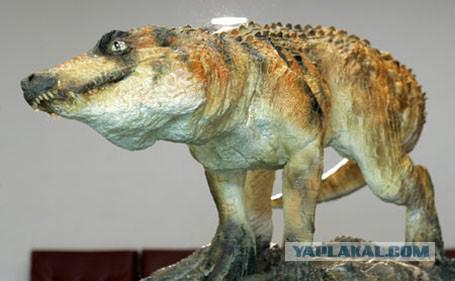
Holy terror
About honoring crocodiles as sacred animals in science spoke 1899, when during excavations in ancient Egypt was discovered mummy of this reptile. As an animal, a leading water lifestyle crocodile god Sobek in the form responsible for the flooding of the Nile. Especially his revered in places close to the water - on the shores of Lake Moeris in the Faiyum, at Kom Ombo. During the Middle Kingdom pharaohs often took the name, consonant with Sobek, such Sebekhotep.
Now the cult of the crocodile survived in New Guinea. Representatives of one of the tribes are required to undergo a painful procedure - of damage to the skin, which will eventually scar. This makes their skin like a crocodile. Kill a sacred animal for their blasphemy.

Jaws
Crocodile - a perfect killing machine. In his jaws from 64 to 70 sharp teeth. But these teeth are not designed for chewing food - they only capture and lacerations production. The crocodile is nothing to worry about losing their teeth - they are changing to a hundred times for life. Scientists estimate that the largest individuals can bite with a force of up to 30,000 Newtons, which corresponds to the severity of 1 ton. This is 3 times the power of white shark bite.
Curiously, when the monstrous power of compression, muscles unclench his jaw so weak that it can suffice the efforts of one hand not to let the crocodile open mouth. In the famous crocodile show often demonstrate this trick. But far more dangerous for a room with a tamer zasovyvaniem head into the jaws monster if only bead of sweat fall to the animal in the mouth jaws are closed in the blink of an eye.
Not so long ago, members of the tourist cruise on the Adelaide River witnessed a unique spectacle. 80-year-old saltwater crocodile named Brutus is not satisfied with the traditional feeding from the boat attacked a medium-sized white shark, which, for whatever reasons, swim in the fresh water. After a successful hunt, the crocodile dragged his victim into the mangroves where easily finished with her. Locals say so Brutus avenged sharks for lost once in their battles with the front paw.
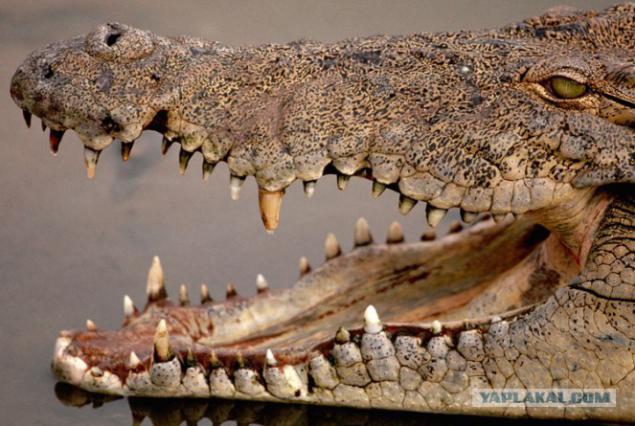
Master and Commander
Saltwater crocodile, which coped with the white shark, also called sea. This is one of the largest predators in the world, exceeding in size even a polar bear. Length saltwater crocodile reaches over 6 meters, it weighs at least a ton. Compared with such dimensions eggs laid by the females seem tiny - and indeed, they are no more than a crow.
Habitat saltwater crocodile is very wide - from the coast of East Africa to the coastal waters of Japan. He could swim in a sea of tens and even hundreds of kilometers. Is under water, it is usually 5-7 minutes, and at a slower metabolism is able to lie low for 2 hours. He prefers lagoons, reefs and mangroves. In these places it has no rivals.
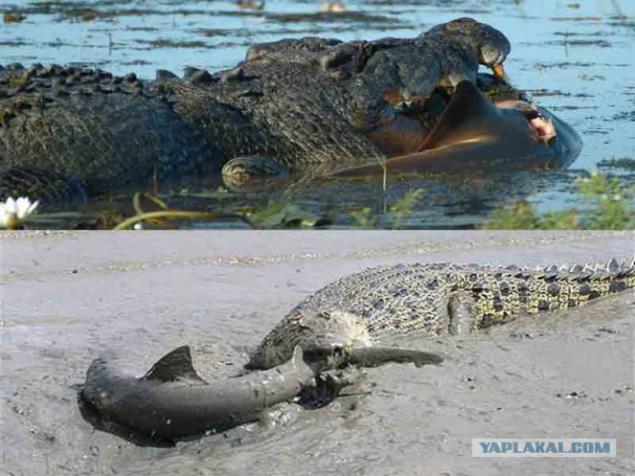
In 2006, the Guinness Book of Records was recorded crocodile living in Indian Park Bhitarkanika National Park. Its parameters are impressive: 7, 1 meter in length and weighs almost 2 tons! However, this specimen lives in captivity. Hunters in the estuarine crocodiles rarely smiled luck catching extra long 6 meters, which is already a feat.
On the strength of this giant can testify facts. Cases when the saltwater crocodile cope with a Bengal tiger and suffolskim stallion, weighed a ton! With the last reptile SPLIT very quickly - dragged the horse into the water and within seconds he turned his neck.
You can not ignore the evidence of the British naturalist Bruce Wright, who participated in the battalion of the Royal Navy in battle with the Japanese army for the island Ramram. Retreating Japanese parts were then attacked by saltwater crocodiles. Of the included marshes Ramram 1,000 Japanese soldiers survived only 20.
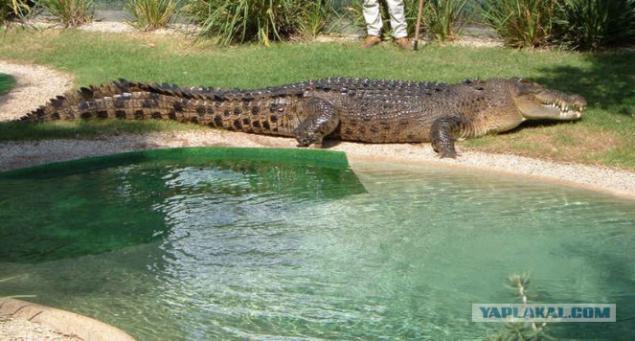
Drevolazayuschie crocodiles
Researchers from the University of Tennessee found that crocodiles can climb trees, climbing to a height of 4 meters. The first person in the most detailed way to study this feature reptiles became a zoologist and explorer Vladimir Dinets. Together with scientists from the Australian Adam Brittany Charles Darwin University and Matthew Shirley from the University of Florida, he came three continents - Africa, Australia and North America, which would investigate in detail drevolazayuschih crocodiles. In its conclusions (Published in Nerpetology Notes) scientists explain this unusual phenomenon is the fact that trees are better suited for thermoregulation crocodiles, as well as to monitor the territory habitat. Probably for the same reason small crocodiles willingly climb on the branches of shrubs and stems of reeds. Previously it was believed that the trees climbed long extinct species of crocodiles.
But crocodiles using vegetation and other purposes. Here Vladimir Dinets also among the pioneers. He found that some crocodiles during hunting may collect twigs for birds to attract attention. "What is really remarkable - predators do not just use the bait, they choose the desired time when birds need to create a nest and looking for sticks to use them" - says ethologist Gordon Burghardt. This is the first case of proving the use of reptiles tools. According Dintsa crocodiles are much smarter than they appear at first sight, and we do a lot of them do not know.
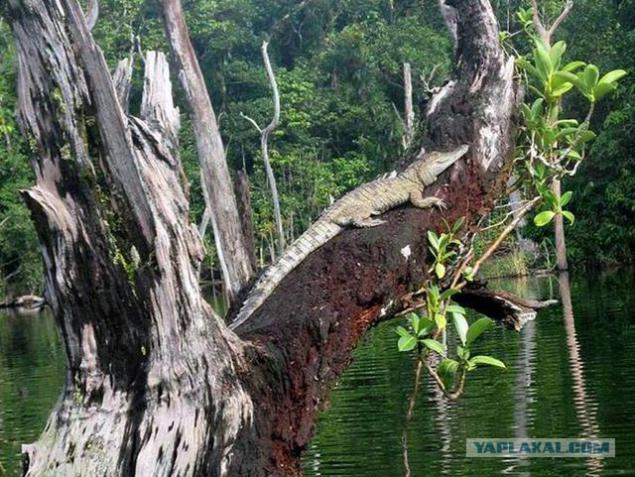
Discoveries continue
A group of scientists led by the already mentioned Matthew Shirley has recently opened a new kind of African gharial (or Slender-snouted Crocodile). Its habitat is in Western and Central Africa. So, the researchers found that in Central Africa, particularly in Gabon, gharial has other morphological features, which later confirmed by genetic examination. Moreover, scientists have ranked this species to disappear. In their opinion, what is traditionally considered one species, evolution was divided into two approximately 7 million years ago.
Earlier, Matthew Shirley found that as there are two different kinds of Nile and three species of dwarf crocodile. But it is not known how to treat its conclusions the global scientific community, because now instead of 3 species of African crocodiles to be as much as 7!
Another discovery of the world of crocodiles, we owe much of TV people. BBC reporters in their films about Australian crocodiles drew attention to the fact that the deep wounds of reptiles each other quickly tightened. Scientists who have taken a blood sample of a crocodile, found one of the previously unknown substance which effectively kills bacteria. Reporters jokingly called this substance "krokodilinom." Now scientists are exploring the possibility of using "krokodilina" already in treating human infections.
All
here

A small overview.

The most ancient lizard
Crocodiles inhabit the planet another 250 million years ago. They began his earthly journey solely as land animals, and only after millions of years moved into waterways.
Dimensions of prehistoric crocodiles were matched to their relatives - dinosaurs. So, one of the extinct species sarcosuchus imperator in length up to 12 meters! By the way, today's crocodiles have more kinship with dinosaurs, and even with birds than modern reptiles.
The living conditions of the crocodiles have changed little since the days of the Triassic period, which partly explains the preservation of their populations.
Millions of years of evolution have created an almost universal organism to adapt to a predatory lifestyle in a variety of habitats. The Company now crocodiles salt metabolism, which gives them the opportunity to live in the sea water, their heart has four chambers framework to better nourish the body with oxygen, they have developed cerebellum contributes to the high coordination.

Holy terror
About honoring crocodiles as sacred animals in science spoke 1899, when during excavations in ancient Egypt was discovered mummy of this reptile. As an animal, a leading water lifestyle crocodile god Sobek in the form responsible for the flooding of the Nile. Especially his revered in places close to the water - on the shores of Lake Moeris in the Faiyum, at Kom Ombo. During the Middle Kingdom pharaohs often took the name, consonant with Sobek, such Sebekhotep.
Now the cult of the crocodile survived in New Guinea. Representatives of one of the tribes are required to undergo a painful procedure - of damage to the skin, which will eventually scar. This makes their skin like a crocodile. Kill a sacred animal for their blasphemy.

Jaws
Crocodile - a perfect killing machine. In his jaws from 64 to 70 sharp teeth. But these teeth are not designed for chewing food - they only capture and lacerations production. The crocodile is nothing to worry about losing their teeth - they are changing to a hundred times for life. Scientists estimate that the largest individuals can bite with a force of up to 30,000 Newtons, which corresponds to the severity of 1 ton. This is 3 times the power of white shark bite.
Curiously, when the monstrous power of compression, muscles unclench his jaw so weak that it can suffice the efforts of one hand not to let the crocodile open mouth. In the famous crocodile show often demonstrate this trick. But far more dangerous for a room with a tamer zasovyvaniem head into the jaws monster if only bead of sweat fall to the animal in the mouth jaws are closed in the blink of an eye.
Not so long ago, members of the tourist cruise on the Adelaide River witnessed a unique spectacle. 80-year-old saltwater crocodile named Brutus is not satisfied with the traditional feeding from the boat attacked a medium-sized white shark, which, for whatever reasons, swim in the fresh water. After a successful hunt, the crocodile dragged his victim into the mangroves where easily finished with her. Locals say so Brutus avenged sharks for lost once in their battles with the front paw.

Master and Commander
Saltwater crocodile, which coped with the white shark, also called sea. This is one of the largest predators in the world, exceeding in size even a polar bear. Length saltwater crocodile reaches over 6 meters, it weighs at least a ton. Compared with such dimensions eggs laid by the females seem tiny - and indeed, they are no more than a crow.
Habitat saltwater crocodile is very wide - from the coast of East Africa to the coastal waters of Japan. He could swim in a sea of tens and even hundreds of kilometers. Is under water, it is usually 5-7 minutes, and at a slower metabolism is able to lie low for 2 hours. He prefers lagoons, reefs and mangroves. In these places it has no rivals.

In 2006, the Guinness Book of Records was recorded crocodile living in Indian Park Bhitarkanika National Park. Its parameters are impressive: 7, 1 meter in length and weighs almost 2 tons! However, this specimen lives in captivity. Hunters in the estuarine crocodiles rarely smiled luck catching extra long 6 meters, which is already a feat.
On the strength of this giant can testify facts. Cases when the saltwater crocodile cope with a Bengal tiger and suffolskim stallion, weighed a ton! With the last reptile SPLIT very quickly - dragged the horse into the water and within seconds he turned his neck.
You can not ignore the evidence of the British naturalist Bruce Wright, who participated in the battalion of the Royal Navy in battle with the Japanese army for the island Ramram. Retreating Japanese parts were then attacked by saltwater crocodiles. Of the included marshes Ramram 1,000 Japanese soldiers survived only 20.

Drevolazayuschie crocodiles
Researchers from the University of Tennessee found that crocodiles can climb trees, climbing to a height of 4 meters. The first person in the most detailed way to study this feature reptiles became a zoologist and explorer Vladimir Dinets. Together with scientists from the Australian Adam Brittany Charles Darwin University and Matthew Shirley from the University of Florida, he came three continents - Africa, Australia and North America, which would investigate in detail drevolazayuschih crocodiles. In its conclusions (Published in Nerpetology Notes) scientists explain this unusual phenomenon is the fact that trees are better suited for thermoregulation crocodiles, as well as to monitor the territory habitat. Probably for the same reason small crocodiles willingly climb on the branches of shrubs and stems of reeds. Previously it was believed that the trees climbed long extinct species of crocodiles.
But crocodiles using vegetation and other purposes. Here Vladimir Dinets also among the pioneers. He found that some crocodiles during hunting may collect twigs for birds to attract attention. "What is really remarkable - predators do not just use the bait, they choose the desired time when birds need to create a nest and looking for sticks to use them" - says ethologist Gordon Burghardt. This is the first case of proving the use of reptiles tools. According Dintsa crocodiles are much smarter than they appear at first sight, and we do a lot of them do not know.

Discoveries continue
A group of scientists led by the already mentioned Matthew Shirley has recently opened a new kind of African gharial (or Slender-snouted Crocodile). Its habitat is in Western and Central Africa. So, the researchers found that in Central Africa, particularly in Gabon, gharial has other morphological features, which later confirmed by genetic examination. Moreover, scientists have ranked this species to disappear. In their opinion, what is traditionally considered one species, evolution was divided into two approximately 7 million years ago.
Earlier, Matthew Shirley found that as there are two different kinds of Nile and three species of dwarf crocodile. But it is not known how to treat its conclusions the global scientific community, because now instead of 3 species of African crocodiles to be as much as 7!
Another discovery of the world of crocodiles, we owe much of TV people. BBC reporters in their films about Australian crocodiles drew attention to the fact that the deep wounds of reptiles each other quickly tightened. Scientists who have taken a blood sample of a crocodile, found one of the previously unknown substance which effectively kills bacteria. Reporters jokingly called this substance "krokodilinom." Now scientists are exploring the possibility of using "krokodilina" already in treating human infections.
All
here
















